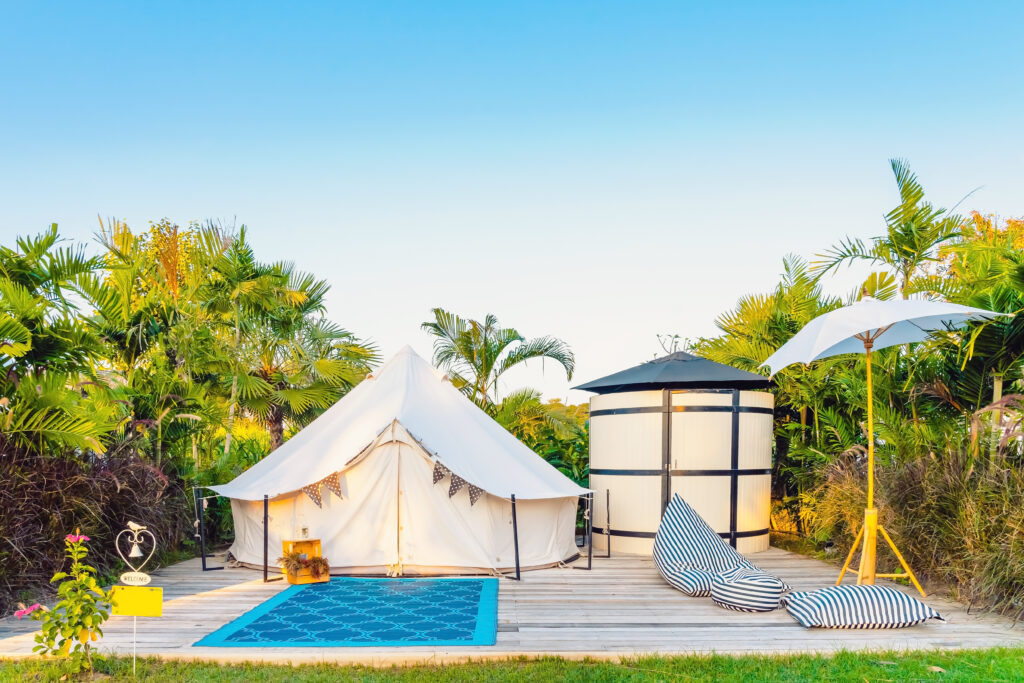When I think of alternative home options, my brain does not automatically bring up the idea of a yurt; after all, a yurt seems more like a dwelling for seasonal camping, not a year-round home. History and tradition will tell us otherwise.
A yurt (Turkish, Russian) or ger (Mongolian) is a portable, circular dwelling made of a wooden lattice made of flexible poles and covered in fabric or felt. They are a sturdy and reliable type of tent. When assembled, yurts often have a rugged floor laid over the ground. The roof or crown is built in a wooden, reed, or fabric pattern specific to the tribe and tradition.

What is the history of the yurt?
Yurts have been the primary home style in Central Asia, particularly Mongolia, for thousands of years. Nomadic tribes in Turkey, Siberia, and Mongolia have lived in yurts for thousands of years. The circular shape of yurts makes wind-resistant in all directions. The doors are often the most vulnerable, so they are made of wood instead of a flap of fabric.
How can a yurt be an alternative housing option?
Yurts can be used today as a dwelling for anyone who wants to live an alternative housing lifestyle. They give you the feeling of home in the wilds of camping or as a rural countryside home. Yurts are similar to tiny houses as they are traditionally one-room structures. Today, yurts are built on a wooden deck-like structure. Yurts come in different sizes, with walls approximately six feet high. The crown adds another three feet. Traditionally, yurts have a wood-burning stove with a chimney. The chimney extends through a hole in the crown.
In what types of climates can yurts be used as permanent homes?

Traditionally, the dry, flat grassland of the steppe has extreme weather. It is very windy due to the lack of trees and shrubs. Winds can be consistent at six miles per hour. The temperature of the steppe can range from 75° Fahrenheit to -19° Fahrenheit.
Where in the U.S. would you be able to comfortably live in a yurt?
According to real estate surveys from USnews.com, here are the areas in the U.S. with the best weather, in which you could probably live in a yurt comfortably without any modifications.
- California
- South Carolina
- Arkansas
- Georgia
- Oklahoma
- Hawaii
While you can fortify your yurt with a/c and a wood-burning stove, it might be best to consult with local yurt builders or others who live in a yurt about the best way to add those modifications to the model yurt you’re considering buying.
What are the different sizes of yurts?
Depending on where you buy your structure, yurts can be found in 12-feet to 40-feet in width and six-foot-high to 10-foot-high walls. The price ranges with these from $7,000 to $55,000.
What kind of yurts can be found in the United States?
Modern yurts come in three types:
- A-frame panel yurt designed by David Raitt.
- The tapered wall yurt was introduced by William (Bill) Coperthwaite.
- The traditional fabric yurt.
The yurts created by yurt builders like Raitt and Coperthwaite are intended to be permanent structures built on a wooden foundation. The fabric yurt is portable. You can sometimes buy them as a yurt kit.
These permanent structures are sometimes referred to as yurt derivations because they stray from the nomadic purpose. They are not easily transportable and collapsible once set up as a permanent home.
Depending on the size, yurts can be built out with interior walls to accommodate separate rooms, regular-sized beds, bathrooms, kitchens, and electricity. Their open floor plan makes them ideal for camping with large groups of people. Five to fifteen people can stay in a yurt comfortably for a short period, like camping instead of a permanent home.
What is the point of a yurt?

Unlike a camping tent, a yurt functions like a real home, protecting people from the elements while still simple enough construction to suit a nomadic lifestyle. There is a space in the center of the yurt for a wood-burning stove and a chimney, which keeps the yurt a warm living space in the winter.
How long do yurts take to assemble and disassemble?
It can take a couple of people half hour to three hours to set up, depending on the size of the yurt. Most modern portable yurts, used primarily for camping, can be erected or broken down in around an hour.
What is the difference between a yurt and a tent?
While they do have some similarities, a yurt differs from a tent because it is more structurally sound than a regular tent. A yurt is supported by its lattice wall and with rafters fortified by a compression ring in the center of the roof.
Why are yurts popular?
Yurts are seasonally popular rental sites. Due to their unique style, people like to experience this form of housing as a rental or camping trip before buying one as permanent housing.
How long do yurts last? Depending on your climate, the fabric cover generally lasts eight to fifteen years. With maintenance and care, the wooden framework of the yurt can last through many generations.
Yurts can be used as permanent alternative housing options in most climates. They are the most comfortable in areas between 75° and -19° with the proper heating and cooling systems. Yurts may not be approved to be in a city or town set by the local building and zoning laws. Consult with your local building inspector to ensure you can have a yurt as a primary dwelling inside your city limits. When approved, consider your local climate and make structural adjustments to the interior to be well suited for the climate in your area.
If you’re interested in yurts, these other 24 ideas for alternative housing options might be right up your alley; also, check out the pros and cons for permanent, mobile, and unconventional alternative housing options.


